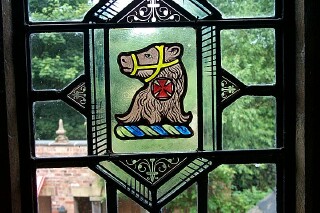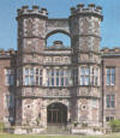|
AN ACCOUNT OF THE PORTRAIT OF
SIR WILLIAM BRERETON I (1550-1631)
By Derek P. Brereton
30 December 1998
In the British room of the European collection at the Detroit Institute
of Arts hangs a portrait of Sir William Brereton I, builder of Brereton
Hall. The portrait is in oil on a cradled wood panel, shows the
sitter at age 28, and was acquired by the museum from Mrs. P. Trelawney
of London in 1950. The artist has not been determined with certainty.
It may have been George Gower, as suggested by James Miller of Sotheby's,
or the Dutch portrait painter, Lucas de Heere.
De Heere, a converted Dutch Calvinist who exiled himself to escape
the Spanish authorities, was in England just prior to the painting's
date, 1579, and earned his living producing portraits of the English
aristocracy. Favoring the de Heere hypothesis are the attribution
to de Heere when the painting was exhibited at the Victoria and
Albert Museum in 1868, and de Heere's name on engravings done from
the portrait. One such engraving is owned by my uncle, Randle Brereton,
and contains written references to both Elizabeth I and Henry VIII
not found on the portrait itself.
The Brereton portrait is in black, save the guilt trim on the doublet,
white lace ruff, and multichromatic coat of arms. Beneath the date
is a Latin inscription which translates, "Picture of William Brereton,
soldier, who founded this house in his 28th year."
Two items stand out. The left hand thumb has been painted over
incorrectly, and juts out at an anatomically difficult angle. The
brush strokes of the overpainting are evident on the portrait itself,
though not on the photograph. More important is the cameo which
Sir William wears in his cap. It is a likeness of Queen Elizabeth
I, who, as Yvonne Hackenbroch notes in "Renaissance Jewelry", gave
them in recognition of meritorious service to the crown. I have
not been able to discover the precise nature of Sir William's service,
but his inclusion of the Queen's initials and arms in the ornamentation
of Brereton Hall leave no doubt as to his loyalty. There is also
a family legend that Elizabeth laid the cornerstone of the hall,
but history disproves it for she was never as far north as Cheshire.
What of the achievement of arms: motto, shield, and crest? The
motto means "With the aid of God." The shield, the simplicity of
which tells its considerable antiquity, is described as "argent
two bars sable". The crest includes the baronial helmet signifying
Sir William's rank. He was knighted at Flushing (Dutch: Vlissingen)
by the Earl of Leicester on 1st May, 1588. Flushing was a coastal
town controlling the approach to Antwerp, and held by the English
from 1585 to 1616. Brereton was created Baron Brereton of Leighlin,
County Carlow (Ireland), 11 May 1624. The crown is, I believe, a
ducal coronet, signifying royal descent. As A. S. Brereton has shown,
the Breretons were - and are - descended from Edward I through Alice
Savage who married the sixth Lord William Brereton (counting from
the beginning, not from the baronage).
 Concerning
the muzzled bear, imaginative theories abound. An early Brereton
murdered a servant, his trial was to engage in combat with a bear,
the bear was muzzled and the accused thus earned his life and freedom.
Or, another Brereton was too outspoken, and the king ordered him
'muzzled'. Again, Henry VIII ordered the bear muzzled after a Malpas
Brereton was executed for adulterous treason with Queen Anne Boleyn.
Though that execution did occur, the truth about the bear may be
rather less romantic. Punning references were common, as a trumpet
for Trumpington, or spear for Shakespeare. For persons with names
sounding in any way like 'bear' it was a common device to include
a bear in the crest. This was true of Barnard, Baring, Barnes, Beardsley
and others, as noted in Arthur Charles Fox-Davies', "The Art of
Heraldry". Fox-Davies also notes that such heraldic bears are normally
muzzled. Thus it seems the Brereton bear follows form, and would
require special pleading only were it shown without a muzzle, and
not because it has one. Concerning
the muzzled bear, imaginative theories abound. An early Brereton
murdered a servant, his trial was to engage in combat with a bear,
the bear was muzzled and the accused thus earned his life and freedom.
Or, another Brereton was too outspoken, and the king ordered him
'muzzled'. Again, Henry VIII ordered the bear muzzled after a Malpas
Brereton was executed for adulterous treason with Queen Anne Boleyn.
Though that execution did occur, the truth about the bear may be
rather less romantic. Punning references were common, as a trumpet
for Trumpington, or spear for Shakespeare. For persons with names
sounding in any way like 'bear' it was a common device to include
a bear in the crest. This was true of Barnard, Baring, Barnes, Beardsley
and others, as noted in Arthur Charles Fox-Davies', "The Art of
Heraldry". Fox-Davies also notes that such heraldic bears are normally
muzzled. Thus it seems the Brereton bear follows form, and would
require special pleading only were it shown without a muzzle, and
not because it has one.
As regards the other coats marshaled on the shield, moving clockwise
after Brereton are Belward, Malpas, Egerton, Orreby, Orreby, and
Corbet. These are families with whom former Breretons had intermarried.
The particular marshaling here is identical to those on the exterior
of Brereton Hall, over the mantle in Sir William's dressing room,
and in the stained glass window formerly at the hall but now removed
to Stoneleigh Abbey. That glass includes an inscription reading
'Breuerton and Savage', for Lord Brereton's bride was Margaret Savage,
with whom he had been raised. Such variations in spelling were common
before modern standardization. I was able to photograph this interesting
glass, as well as the grand representations of the nine Earls of
Chester also formerly in Brereton Hall, and will make copies available
at the reunion.
Finally, the provenance of the portrait seems to have been as follows.
When no claim to the title was made after the fifth Lord Brereton
died sans progeny in 1722, the estate went to the Holte family due
to the marriage of Sir Robert Holte to Lady Jane Brereton, sister
of the second Lord Brereton, grandson of the man whose portrait
we are considering. Later, Mary Elizabeth Holte married Abraham
Bracebridge, thus accounting for the Bracebridge possession of the
portrait in 1922, when Arthur Moir wrote of it in "The Story of
Brereton Hall", Cheshire. Robert Holte's son built Aston Hall, which
now holds the long, ancient kitchen table from Brereton Hall, a
tapestry by Mary Holte (1684-1759) depicting Brereton Hall, and
portraits of Lady Jane Brereton and Sir William Brereton III, a
founder of the Royal Society.
The Detroit Institute of Arts acquired the portrait from Miss P.
Trelawney in 1950, who must therefore have gotten it from the Bracebridges.
The Trelawneys also had a connection with Brereton through Edward
Trelawney (1792-1874), the swashbuckler who accompanied George Gordon,
Lord Byron and Percy Bisshe Shelley on their exploits in Greece
and Italy. Margaret Armstrong has written a historical novel, "Trelawney",
concerning these adventures. Edward Trelawney's father was Charles
Brereton Trelawney, heir presumptive to the very large Brereton
estate on the Wirral Peninsula, formerly owned by his cousin, Owen
Salusbury Brereton, antiquarian and member of parliament. Thus the
portrait probably went from Brereton Hall to the Holte family, then
to Atherstone Hall due to the Bracebridge connection, and from there
to the Trelawneys and the Detroit Institute of Arts.
It is of great interest that Marguerite Poland of South Africa,
herself a Brereton, owns another portrait of a Sir William Brereton.
This is an older man who could well be the same individual as the
one in the Detroit portrait, though the identity of neither the
sitter nor the artist is certain.
[ The actual photos will be included at a later
time. ]
|
|
|

